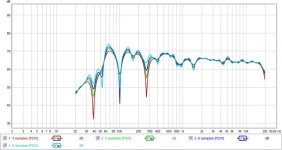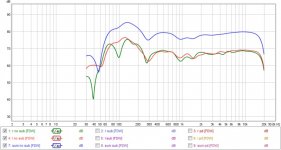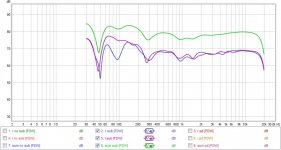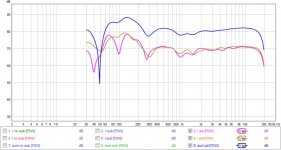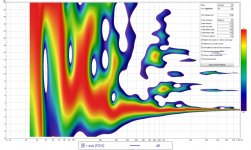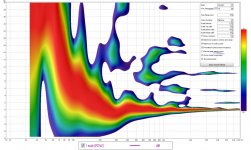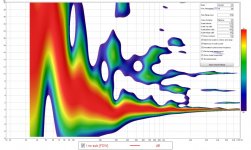....They are crossed at 300Hz and 2500Hz right now.
Oh that info push for thinking about if you accidently somewhere in chain have polarity wrong for new 9,5 incher and simply need to flip polarity for that particular pass-band.
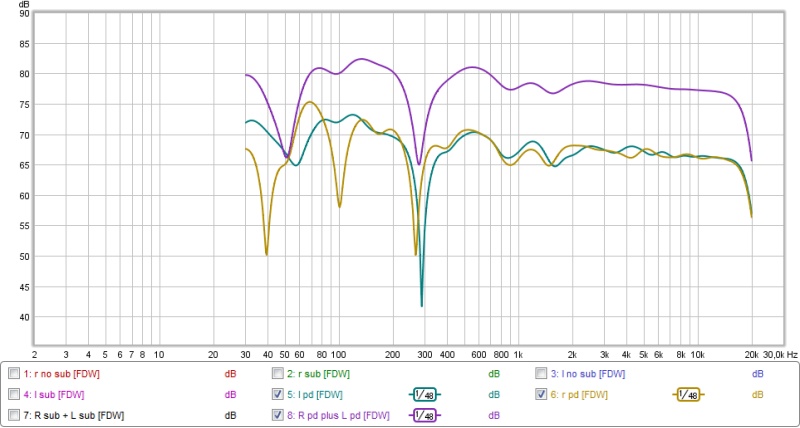

Last edited:
I'll try playing with the crossover a bit. They are crossed at 300Hz and 2500Hz right now.
I kept thinking to post, that surely the dip at 300 is polarity mismatch...??
Never seen a room mode that strong...
Now that I see you're at 300 Hz crossover.... i HAVE to post 🙂
edit: ...I see you beat me to the post BYRTT 🙂
edit: ...I see you beat me to the post BYRTT 🙂
😀... synchronize at 10:29 PM
Same crossover as the distortion measurements at 1m no dip at 300. Those two measurements were taken maybe 30 minutes apart and I didn't flip the polarity just to mess with you guys 😛
Same crossover as the distortion measurements at 1m no dip at 300. Those two measurements were taken maybe 30 minutes apart and I didn't flip the polarity just to mess with you guys 😛
Hi, I must be missing the post without a dip at 300...I've gone back a few pages but can't find one ??? Sorry if I'm just dense here 🙂
The wavelet could tell you that:
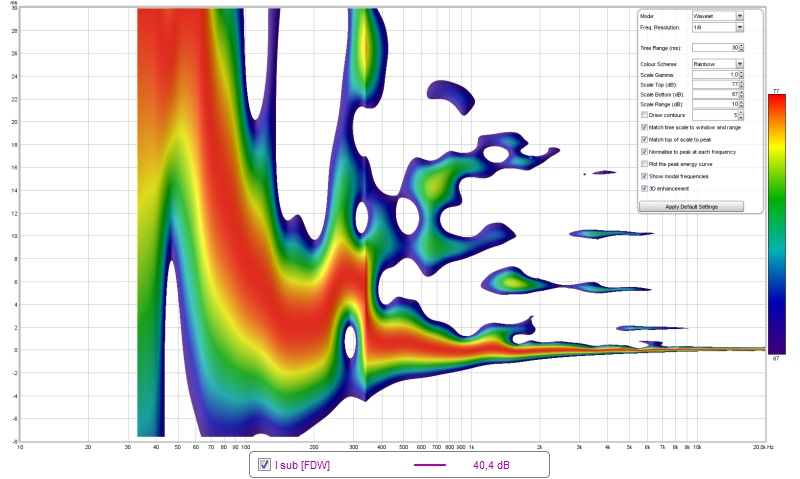
The dip gets filled in over time. What does it look like at one cycle FDW. If there's already a dip at one cycle is would mean it's out of phase. Creating that U shape. If it isn't showing a dip at one cycle in the same place (~300 Hz), you could be dealing with a reflection or room mode. Time to look at a filtered IR to see if that provides clues in that case.
In case there is a dip at one cycle:
Why it's out of phase would depend on how the phase at the crossover sums.
If you do measure up close, what are the distances from mic to each driver that hands over at 300 Hz? And what are the distances with mic at the listening position?
Does this relationship change at listening distance? What is the difference in distance to drivers and mic in both situations? It doesn't have to be flipped polarity, it could (just) be a timing difference.
If you run the woofer solo without a low pass, measure it in the same position as in this graph, do you get the same dip? Or the mid without a high pass, what does that look like? You could be close to a room mode at the crossover. In that case a slightly different crossover point might be more beneficial, depending on which driver does that area better. Also try it with the woofer enclosure upside down. It's now up near to the mid right? So you have the (extra) option to have it low by the floor to test.
Going by this picture:
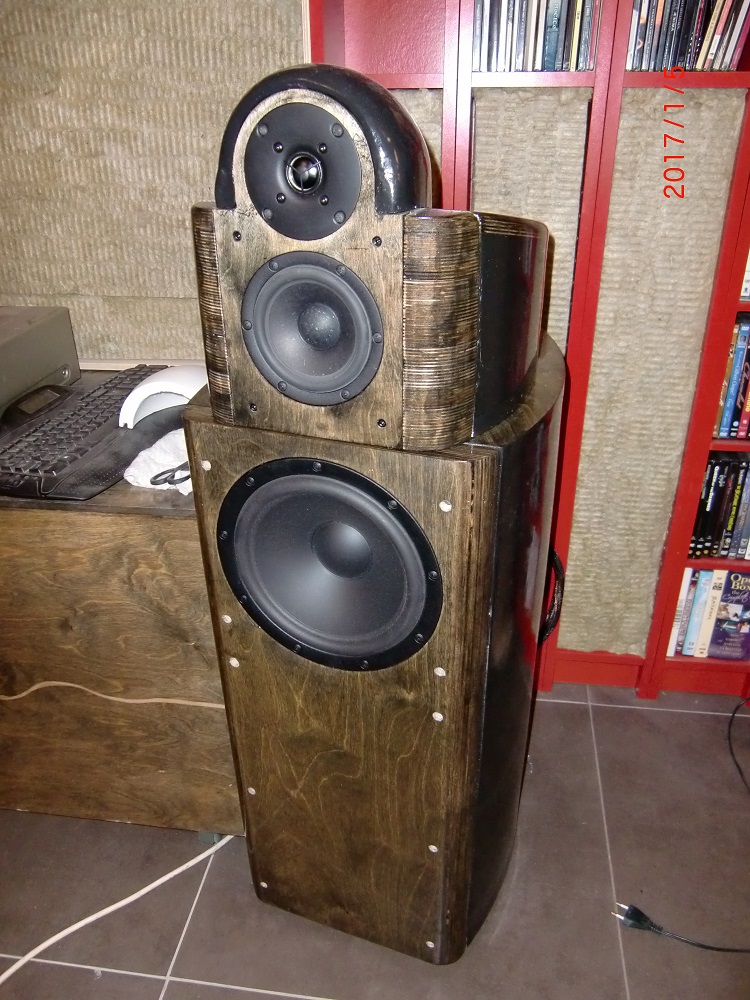
Assuming the enclosures are separate or the baffle can be placed upside down.
Just throwing out ideas to play with here...
Last edited:
By the way, an APL plot could tell you more too. Also with the single woofer or mid and no crossover at that 300 Hz position. To me it kinda looks like the woofer is firing early, relative to the mid, thus not summing. Any phase manipulation on separate drivers going on? Or any FIR part at all in these measurements we should know about?
@ Mark101: post 95
1 sample:
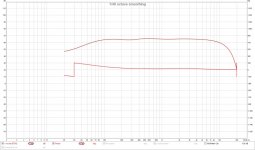
No dip.
I can lower the driver but not to the floor, I can put it as low as were the 26W used to be but it would require a new baffle. Also I really like the coherent sound and having the center of the drivers apart by more then 0.5m with a crossover point around 300 seems a bit counter intuitive.
Also the reason I went with a crossover point at 300 in the first place (mentioned somewhere in the first pages of this thread) was to spread the sound over a wider area hoping to somewhat alleviate the floor bounce. It was allready present with my first 3-way with 10F.
I build the crossover using rephase and measurements of the drivers in the enclosure at 1m with a huge pile of blankets between driver and speaker. 1023 taps for woofer, 800 for mid and 150 for tweeter. No other FIR stuff going on.
I'll get APL working 😉
1 sample:

No dip.
I can lower the driver but not to the floor, I can put it as low as were the 26W used to be but it would require a new baffle. Also I really like the coherent sound and having the center of the drivers apart by more then 0.5m with a crossover point around 300 seems a bit counter intuitive.
Also the reason I went with a crossover point at 300 in the first place (mentioned somewhere in the first pages of this thread) was to spread the sound over a wider area hoping to somewhat alleviate the floor bounce. It was allready present with my first 3-way with 10F.
I build the crossover using rephase and measurements of the drivers in the enclosure at 1m with a huge pile of blankets between driver and speaker. 1023 taps for woofer, 800 for mid and 150 for tweeter. No other FIR stuff going on.
I'll get APL working 😉
So its the room, was that measurement up close? The reason to drop the woofer to the floor is getting it closer to its floor image. You can still have a coherent sum at the listening distance. Drivers within 1/4 wave distance is good, but if it doesn't get you what you want at listening distance, then what. Dropping it half way isn't what changes the woofer floor interaction. Being sure there are differences between woofer/floor and mid/floor interaction might give you other options. Phase manipulation isn't going to help if the first cycle shows no dip. Changing room/driver distances might. What good does it do you to have it measure great at 1m if you don't sit there. Look for an option to work with the room. Multiple woofers could have helped out. Positioning the woofer differently was an option to see the interaction.
Last edited:
I was already in the process of posting an apology...yes, I found your previous graphs / posts.
very nice project btw !!!
@ weysayso: Point taken, I'll run a measurement with the basscabs turned upside down this afternoon. There is room in the enclosure for another satori, but Q will go from about 0.6 now to 7.5 without a linkwitz transform.
@ mark100: no need for an apology, there are a lot of measurements in this thread 🙂
@ mark100: no need for an apology, there are a lot of measurements in this thread 🙂
@ weysayso: Point taken, I'll run a measurement with the basscabs turned upside down this afternoon. There is room in the enclosure for another satori, but Q will go from about 0.6 now to 7.5 without a linkwitz transform.
Think of the virtual woofer in the floor reflection not obeying quarter wave distances at the moment.
If you mean the slight change in FR shape due to having 2 woofers, that could be cured with a bit of PEQ/FIR.
SBIR calculator
Take location of your mic while measuring next time and make a simul using sbir to see if it is corelated.
I would say this is a room artifact.
Take location of your mic while measuring next time and make a simul using sbir to see if it is corelated.
I would say this is a room artifact.
Last edited:
Less deep dip at 300, there might be more possible with a slight crossover/timing change.
EQ-ing the new found bump flat with PEQ/FIR.
It would be interesting to see both scenario's in APL_TDA.
However letting the woofer play solo, without a top end crossover (removing low pass) with woofer on top, comparing to woofer at bottom could give you all the answers you need.
There's still hope a slight rework of the crossover can help get the dip out of the way.
The new bump means the sum of the mirror and bottom woofer add up pretty good.
So what do you think?
If I were you, if at all possible, I'd fabricate a new baffle with 2 woofers (A single one first, to try on both sides). If that works even better you could think about ordering 2 more Satori's. Probably worth a shot, almost free to try, more expensive if it works out 😀.
EQ-ing the new found bump flat with PEQ/FIR.
It would be interesting to see both scenario's in APL_TDA.
However letting the woofer play solo, without a top end crossover (removing low pass) with woofer on top, comparing to woofer at bottom could give you all the answers you need.
There's still hope a slight rework of the crossover can help get the dip out of the way.
The new bump means the sum of the mirror and bottom woofer add up pretty good.
So what do you think?
If I were you, if at all possible, I'd fabricate a new baffle with 2 woofers (A single one first, to try on both sides). If that works even better you could think about ordering 2 more Satori's. Probably worth a shot, almost free to try, more expensive if it works out 😀.
Last edited:
...To me it kinda looks like the woofer is firing early, relative to the mid, thus not summing...
Not shure but could look like there is something about above both in old and new wavelets, below at left side is the new one and to the right a 2mSec brick wall time change at XO point 🙂
Attachments
I noticed 🙂. That's the slight rework I was getting at before I saw the wavelets.
Get that right and this single change might be all that is needed at 300 Hz.
Still some room damping to do and minor PEW/FIR work could get it further in shape.
I felt I was being a bit pushy yesterday evening, but now I'm glad I spoke up. 🙂
Another example that it pays off to look at what happens out in the room. Making a deviation from original goals
(to be within 1/4 wave distance) seem less important if it means worse room effects if you don't. As DIY we can tailor to our specific
needs. Using that fact is our big advantage.
Get that right and this single change might be all that is needed at 300 Hz.
Still some room damping to do and minor PEW/FIR work could get it further in shape.
I felt I was being a bit pushy yesterday evening, but now I'm glad I spoke up. 🙂
Another example that it pays off to look at what happens out in the room. Making a deviation from original goals
(to be within 1/4 wave distance) seem less important if it means worse room effects if you don't. As DIY we can tailor to our specific
needs. Using that fact is our big advantage.
Last edited:
- Status
- Not open for further replies.
- Home
- Loudspeakers
- Multi-Way
- Achilles FIR 4-way
